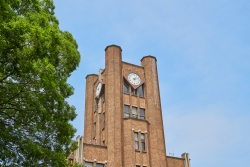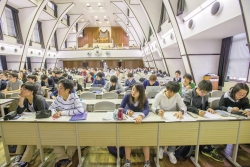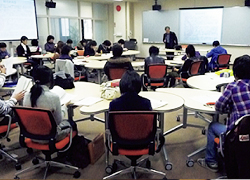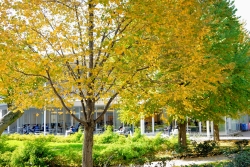The Location of Universities of of Arts and Sciences Is Important
Higher of Arts and Sciences
All first- and second-twelvemonth students of the University of Tokyo study at the Higher of Arts and Sciences on Komaba Campus. The ii-yr Junior Division provides a comprehensive liberal arts instruction.
Aiming to cultivate "cross-border cognition" within students, the Senior Segmentation of the College of Arts and Sciences provides teaching that focuses on humanities, sciences, and interdisciplinary areas integrating arts and sciences.

Upon the introduction of the College of Arts and Sciences into the University of Tokyo in 1949, Tadao Yanaihara, the commencement dean of the College (who would after go the University'south 16th president), is said to have commented every bit follows:
"The importance of the Junior Partitioning of the Higher of Arts and Sciences, which is comprised of half of the undergraduate student body, lies not simply in its numbers. All students of the University study at the Inferior Partition for their offset two years, thereby condign immersed in the spirit of its new academy education system. The Junior Sectionalisation is non the Preparatory School for entering the University of Tokyo, but rather a part of the University—and a significantly of import function, at that. In the Junior Sectionalisation, students receive a full general liberal arts teaching, which provides the basis for acquiring knowledge on a deeper and more than technical level. By possessing this strong foundation of knowledge, they volition be less decumbent to bias, and will be encouraged to cultivate a boundless enthusiasm for pursuing the truth. This enthusiastic spirit is the very heart and soul of the Junior Division of the College of Arts and Sciences."
Although more 70 years have passed since Professor Yanaihara's argument, the origins of the University of Tokyo's educational principles are nonetheless present in the College of Arts and Sciences today. For example, if y'all have the opportunity to read the Lease of the University, yous will find the following passage:
"The University of Tokyo will open up its doors on all of its campuses to everyone with suitable qualifications and bent for learning. In each branch of higher learning, it will nurture people of leadership qualities who possess an international character and a pioneering spirit in addition to being equipped with expert knowledge, comprehension powers, insight, practical strengths and imagination. Toward this goal, the University of Tokyo volition seek the highest standard of didactics in the world, all the while respecting the individuality of students and their right to larn." In October 2012, PEAK (Programs in English at Komaba), undergraduate degree programs taught exclusively in English language, welcomed their first students.
The University emphasizes the importance of the Komaba Campus' Junior Segmentation so that new students can utilize both the broad perspectives and overall fundamental skills they cultivate during their two years here to subsequently larn a high caste of specialized pedagogy. This basic educational strategy is referred to as "late specialization."

In add-on to beingness the school in charge of the Inferior Division education for all the Academy'due south commencement- and 2nd-year undergraduate students, the Higher of Arts and Sciences provides a unique specialized education in its Senior Division, which is known as the Kinesthesia of Arts and Sciences. Focusing on the keywords "interdisciplinarity," "internationalization" and "innovativeness," the Faculty of Arts and Sciences has aspired to foster "cross-border knowledge" within students. In other words, the Faculty encourages students to have interests in many fields, actively involve themselves in culturally and linguistically different environments, and take the initiative to explore new areas of learning.
Since the foundation of the College of Arts and Sciences in 1951, the Kinesthesia of Arts and Sciences at Komaba has been quick to innovate courses transcending traditional disciplines, such as international relations. Recognizing electric current societal demands, also equally a response to the changing times, the Faculty implemented an all-encompassing reshuffling of its departments in 2011. Since so, the Faculty of Arts and Sciences is comprised of three departments: Department of Humanities and Social Sciences, Department of Interdisciplinary Sciences, and Section of Integrated Sciences.
The Department of Humanities and Social Sciences, which focuses on the areas of humanities, is made up of three Sub-Departments, differing in their focus and approach: Interdisciplinary Cultural Studies, Surface area Studies and Social and International Relations. The Sub-Department of Interdisciplinary Cultural Studies consists of 7 courses: Cultural Anthropology, Culture and Representation, Comparative Literature and Arts, Contemporary Thought and Philosophy, Interdisciplinary Japanese Cultural Studies, Interdisciplinary Language Sciences, and Studies on Language, Text and Culture. The Sub-Department of Area Studies has nine courses: British Studies, French Studies, German Studies, Russian and Eastward European Studies, Italian / Mediterranean Studies, North American Studies, Latin American Studies, Asian and Japanese Studies, and Korean Studies. The Sub-Department of Social and International Relations contains two courses: Interdisciplinary Social Sciences, and International Relations.
The Department of Interdisciplinary Sciences, which covers fields that integrate arts and sciences, comprises four courses: Science and Technology Studies, Geography and Spatial Design, Informatics, and Full general Organisation. Also, the Department offers six sub-programs: Science and Technology Studies, Geography and Spatial Pattern, Informatics, General System, Environmental Sciences, and Evolutionary Biology.
The Department of Integrated Sciences, which centers on the sciences, consists of v courses: Mathematical Sciences, Matter and Materials Science, Integrated Life Sciences, Cerebral and Behavioral Sciences, and Sports Sciences. Each department provides a unique and distinctive instruction.
Also, in Oct 2012, the College of Arts and Sciences started an all-English language caste plan chosen Height (Programs in English language at Komaba). Students from all over the world enter the program equally get-go-yr students through an admissions procedure resembling that of western countries. They are enrolled in the International Full general Teaching Program during their ii years in the Junior Partitioning, after which they choose to keep to either the International Program on Japan in East asia or the International Plan on Environmental Sciences for their Senior Division course. Students who entered the University through the traditional exam method may also advance to a Senior Division Tiptop program as long as they run across certain requirements.

Because the College of Arts and Sciences features a large number of academic staff members who carry out research in a variety of fields, many of the Faculty'due south classes are provided under ideal low pupil-to-instructor ratios. The humanities-related courses offer classes that encompass many foreign languages, enabling students to acquire a global perspective that does not bias them toward a particular region. For languages that are regarded as being of particular importance, the department provides advanced classes which aid students to obtain a loftier level of language ability. The goal of this department is to cultivate talented individuals who can communicate finer in the international community and come upwardly with flexible ideas that go beyond the boundaries of bookish disciplines.
The sciences-related courses offering unique educational programs not limited to one specific subject field. Students can acquire technical knowledge and insight that extends across more than one area. They tin then employ what they learned as a foundation for endeavoring into more advanced disciplines.
The interdisciplinary courses intend to foster talented people who can handle new challenges from comprehensive viewpoints. These people will be able to utilize appropriate methodologies and flexible ways of thinking that are not strictly limited to either the humanities or the sciences.
In addition, the Faculty offers cross-disciplinary programs that do not fit into any of the fields covered by the abovementioned departments, including the Global Ethics, Evolutionary Cognitive Brain Science, Scientific discipline Interpreter, Global Studies and Trilingual Eastward Asian Studies.
As can be seen, the defining characteristics of the Senior Division of the College of Arts and Sciences prevarication in the variety of programs and learning methods the College offers to encourage students to go beyond disciplinary borders.
Departments of the Senior Division
Plummet

Department of Humanities and Social Sciences
Interdisciplinary Cultural Studies
Expanse Studies
Social and International Relations
Japan in East asia (PEAK): International programme offered in English language
Department of Interdisciplinary Sciences
Science and Engineering Studies
Geography and Spatial Blueprint
Informatics
Full general System
Evolutionary Biology
Environmental Sciences (Height): International programme offered in English
Department of Integrated Sciences
Mathematical Sciences
Matter and Materials Science
Integrated Life Sciences
Cognitive and Behavioral Sciences
Sports Sciences
Cantankerous-disciplinary Programs
Global Ethics
Evolutionary Cerebral Brain Scientific discipline
Science Interpreter
Global Studies
Trilingual E Asian Studies
Type of Degree
Bachelor of Liberal Arts
Senior Division Section: kouki.c AT @gs.mail service.u-tokyo.air-conditioning.jp
Website
rinehartnaromancles.blogspot.com
Source: https://www.u-tokyo.ac.jp/en/academics/cas.html
0 Response to "The Location of Universities of of Arts and Sciences Is Important"
Post a Comment